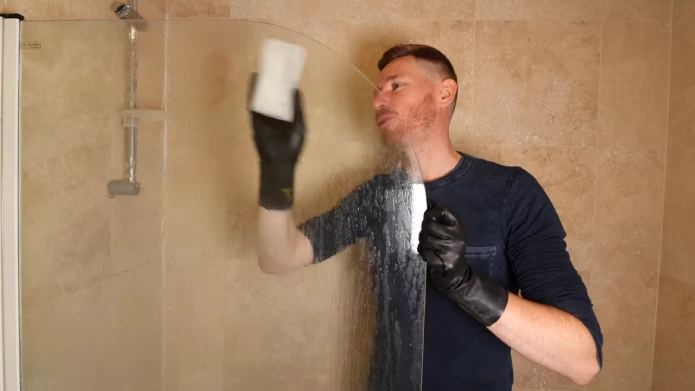Last Updated on March 6, 2023
Lime buildup on glass shower doors can be unsightly and difficult to remove. The buildup is caused by hard water, which contains a high level of minerals such as calcium and magnesium. These minerals can leave behind stubborn stains and a cloudy film on the glass.
Regular cleaning can help prevent the buildup, but if you already have lime stains on your shower doors, there are a few effective methods for removing them. One common method is using a solution of white vinegar and water. Mix equal parts white vinegar and water in a spray bottle.
Spray the solution onto the lime buildup, let it sit for a few minutes, and then scrub with a squeegee or brush. Rinse thoroughly and dry the doors with a clean cloth.
We will provide step-by-step instructions on how to use natural ingredients such as baking soda, vinegar, lemon juice, and even toothpaste to get rid of your shower doors of lime build-up once and for all. Read on to learn more about cleansing lime off glass shower doors without breaking the bank or damaging the surface.
How to Clean Lime Off Glass Shower Doors: Follow 6 Steps
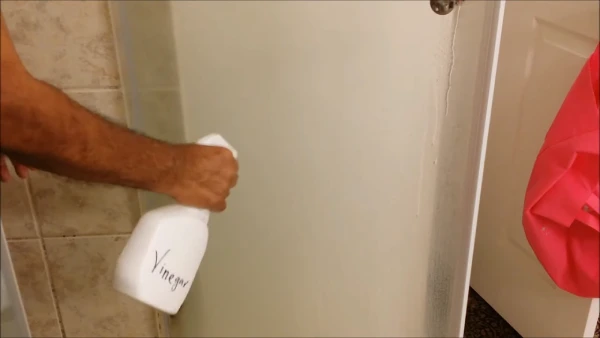
Step 1: Prepare the cleaning solution by mixing white vinegar and water into a spray bottle. Make sure to use an appropriate amount of each ingredient, depending on the size of your shower door.
Mix one part baking soda with two parts white vinegar or lemon juice into a paste. Make sure to use protective gloves when handling the mixture.
Step 2: Apply the mixture to the shower door and let it sit for at least 15 minutes. This will allow the acid in the vinegar or lemon juice to break down the limescale.
Step 3: After allowing the mixture to sit, take a soft-bristled brush (such as an old toothbrush) and gently scrub away at any remaining limescale deposits.
You can also use a scrubbing sponge or scouring pad to remove any remaining limescale. Use circular motions to remove all lime traces from the glass surface thoroughly.
Step 4: Once you’re done scrubbing, and all of the limescale is removed, rinse off your shower door with warm water and a cleaning cloth until all of the soap residues are gone.
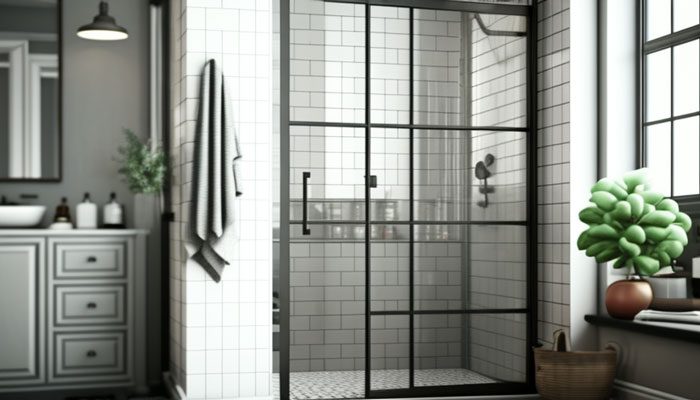
For best results, use a squeegee after rinsing to remove any excess moisture from your glass shower door. Ensure that all soap scum is removed as well during this step.
Step 5: To help prevent limescale buildup on future showers, try using an anti-limescale solution after each use of your shower door.
These solutions typically contain phosphates and other chemicals that create a barrier around your shower door that helps reduce limescale accumulation over time.
Step 6: Finally, use a squeegee or clean microfiber cloth to wipe down the entire glass surface to remove any streaks or smudges that may have been left behind from cleaning.
With regular maintenance, this should be enough to keep your shower door free from limescale build-up in between deep cleanings.
Reasons for Cleaning Lime from Shower Doors

Cleaning lime from shower doors is an important task to ensure the proper functioning of plumbing fixtures and to keep your shower area looking its best. There are three major reasons:
1. Prevents Permanent Damage to Glass
Cleaning prevents permanent damage to the glass. Lime buildup on glass surfaces can cause etching, discoloration, and cloudiness, which will only worsen over time if not properly addressed. This can severely reduce the lifespan of your shower door, so it’s important to start cleaning off those deposits as soon as you discover them.
2. Removes Unsightly Build-Up of Limescale
It removes the unsightly build-up of limescale. Limescale is a hard sedimentary deposit that forms when calcium and magnesium ions in water react with soap suds or other cleaning products.
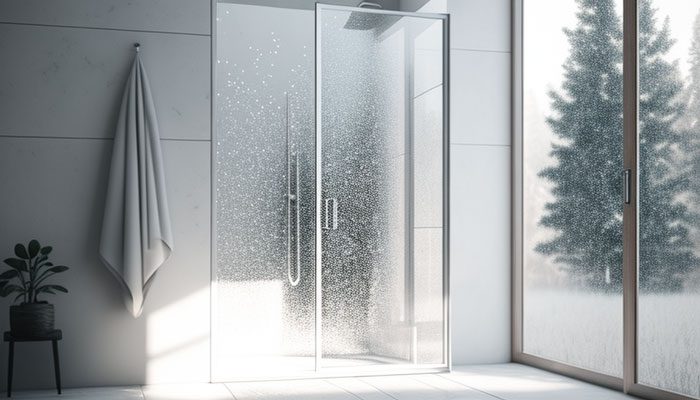
It’s often gray or white and accumulates near faucets and fixtures due to standing water or steamy showers. Cleaning off this mineral residue helps make any bathroom look cleaner and more appealing.
3. Improves Overall Look and Feel of the Shower Area
The shower area is also improved in terms of appearance and feel. Limescale deposits can be removed to restore the glass’ original shine and clarity, making the shower area look newer and more inviting to family members and guests.
In addition to providing a better guest experience, it also increases the aesthetic value of your home since a clean bathroom is considered one of the most important factors in determining the value of a property.
Why Does Baking Soda Remove Limescale?

Baking soda, or sodium bicarbonate, is a great product for removing limescale. Limescale is a hard, chalky buildup caused by mineral deposits from hard water. It often appears on cooking utensils, bathroom and kitchen surfaces, and other areas where water has been left to dry.
Baking soda is an ideal choice for removing lime scale due to its chemical properties and simple application process.
Reason 01: Alkaline Nature of Baking Soda
The first reason why baking soda removes the lime scale is because of its alkaline nature. Baking soda has a higher pH than the pH found in most hard waters that contain minerals like calcium carbonate and magnesium carbonate.
When baking soda comes into contact with the deposits of minerals found in limescale, it chemically reacts with them and breaks them down into smaller particles that can be easily scrubbed away.
Reason 02: Abrasive Nature of Baking Soda
The second reason why baking soda can remove lime scale is on account of its abrasive nature. When mixed with water and applied as a paste or spray, baking soda provides an abrasive surface which helps loosen up the mineral deposits found in limescale.

The small granules of baking soda act like tiny scrubbing particles that can help break up the stubborn limescale buildup without damaging your surfaces or cookware.
Reason 03: Presence of Detergent Properties
Finally, baking soda also contains mild detergent properties, which can aid in loosening up grease and dirt that may also be present on limescale surfaces.
Therefore, when you use baking soda to remove limescale from cookware or bathroom fixtures, you will also be cleaning the residue, dirt, or grease underneath the limescale that may have been trapped.
How Do You Remove Calcified Limescale from Glass Shower Doors?
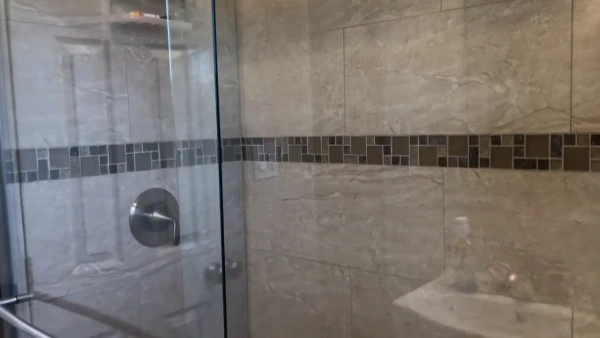
Step 1: Prepare the area
Put on a pair of rubber gloves, safety glasses, and a long-sleeved shirt to protect yourself from any flying debris or splashes of cleaning solution. Remove any glass shower door accessories, such as bars, towel racks, or shelves, that are attached to the glass surface.
Step 2: Make a paste
Mix together white vinegar and baking soda to make a paste. Apply the paste to the affected surfaces, covering them completely with an even layer of the mixture. Allow it to sit for at least 45 minutes and up to several hours so that it has time to break down the calcium deposits.
Step 3: Clean off the paste
Once it has had time to work, use a soft cloth or scrub brush dipped in warm water to wipe away the paste and any remaining limescale deposits from the glass shower door surface.
Use firm pressure when scrubbing if necessary but avoid using sharp objects or abrasive cleaners as these can cause damage or scratches to the glass door surface.
Step 4: Rinse off residue and dry thoroughly
When all of the limescale has been removed from the surface of the glass shower door, rinse it off with clean water, ensuring all of the vinegar and baking soda residues are gone before drying with a microfiber cloth or squeegee.
Then allow the surface to air dry completely before reattaching any accessories back onto your glass shower doors.
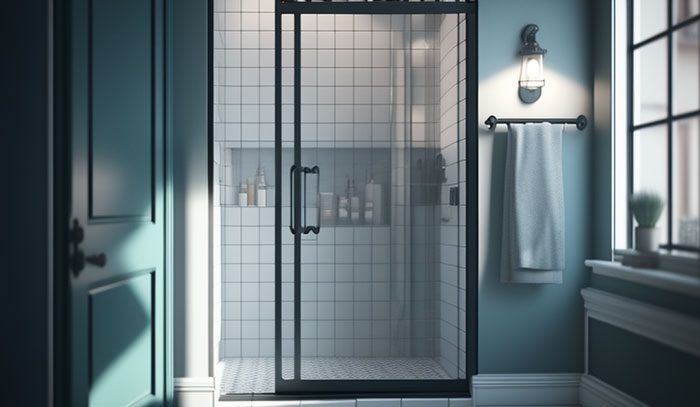
Step 5: Repeat Steps 2-4 if necessary
Until all limescale has been removed from your glass shower doors. Consider repeating this process more than once on stubborn areas of calcified limescale buildup.
Instead of using white vinegar and baking soda alone, try mixing lemon juice with baking soda instead for an extra boost of acidity, which will help break down more inflexible deposits more effectively than vinegar alone.
How Do You Get Thick Limescale off Shower Doors?

Step 1: Gather the materials you will need white vinegar, baking soda, a squeegee or scraper, a soft cloth or sponge, and a bucket filled with warm water.
Step 2: Create your cleaning solution by combining equal parts of white vinegar and baking soda in the bucket filled with warm water. Stir this mixture well until it is homogenous.
Step 3: Using the soft cloth or sponge, evenly apply the solution to the areas of your shower door that are covered in limescale. Allow it to sit on the glass for approximately five minutes.
Step 4: Begin scrubbing those areas with limescale gently with the cloth or sponge you used to apply the solution. If necessary, use some moderate pressure to help loosen any stubborn bits of mineral deposits.
Step 5: Use a squeegee or scraper to scrape away any remaining residue. Be sure not to press too hard against the glass, as this can cause scratches and damage. Rinse off any excess solution left behind with water from a garden hose or sink faucet head if necessary.
Step 6: Dry off any remaining wet spots on your shower door using a clean, dry towel or newspaper page so that no streaks are left behind when you’re done cleaning.
Step 7: To prevent future build-up of limescale, be sure to rinse off your shower area regularly after use and avoid leaving soap scum residue on its surface for extended periods of time, as this can lead to more mineral accumulation over time.
Final Thoughts
Cleaning lime off glass shower doors doesn’t have to be a complicated or expensive process. With the right supplies and knowledge at hand, anyone can make their showers sparkle again without resorting to harsh chemicals, which can be harmful both for people’s health as well as our environment.
We gave you step-by-step instructions for removing limescale buildup on your shower door using baking soda, vinegar, lemon juice, and even toothpaste.
Not only is it easier for us and the environment, but it’s also cheaper than buying expensive chemical cleaners. Cleaning up your glass surfaces doesn’t have to be difficult if you follow these simple steps, don’t let limescale take over.

